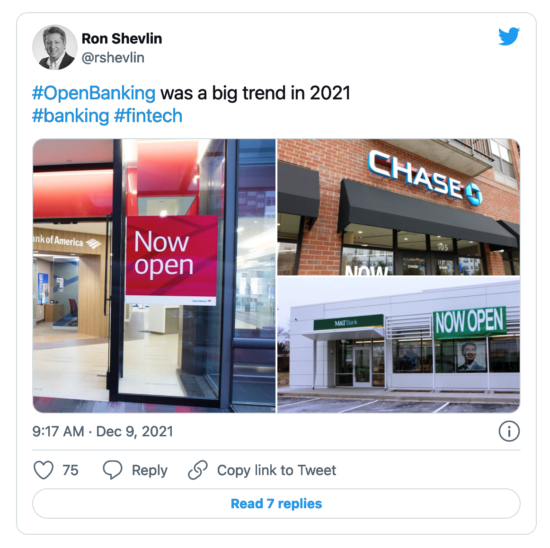

This list of top banking and fintech trends for 2022 won’t tell anyone anything they haven’t already heard about. It’s meant to help financial institutions plan for 2022—i.e., what trends should be on their strategic priority list for the coming year.
In June 2021, following Ally Bank’s announcement that that it would no longer charge its customers an overdraft fee, I published an article titled, “It’s Time To End Overdraft Fees (And Chase Bank Is Just The Bank To Do It),” in which I speculated:
“Banks and credit unions will wait and see who else eliminates overdraft fees. If nobody blinks, the issue goes away. But if a few make the move, there will be a rush, because no one will want to be the last financial institution with overdraft fees.”
The big guys blinked:
They don’t necessarily have to eliminate the fee altogether, however. According to Terence Roche, partner at consulting firm Cornerstone Advisors, community-based financial institutions could:
“Lower their NSF fee to the $5 to $7 range and market it as a convenience fee. Let the customer choose whether to pay the check for the fee or return it with no fee, and give the same choice for debit—pay with fee or decline without.”
This coming overdraft fee overhaul will be a boon for technology providers that help financial institutions with the analytics needed to determine which customers should get which overdraft offer and provide real-time notifications to customers.
If (like me) you’re tired of hearing bankers say, “We’re a technology company with a bank license,” you’re going to really hate it when bankers start telling the world, “We’re a Web3 gateway with a bank license.”
Granted, the numbers don’t quite portend an onslaught of banks getting into crypto. In Cornerstone Advisors’ 2022 What’s Going On In Banking study, just 10% of financial institutions said they’ll launch crypto investing services in 2022 with another 13% planning a 2023 launch. I’m anticipating even more adoption in 2022 due to:
In U.S.-based bank board meetings in 2015, directors told their management teams about how their grandchildren were on Facebook every day and wanted to know what the bank was doing about social media.
In 2022, board members will tell their management teams about their grandchildren’s Bitcoin investments and want to know how the bank plans to respond.
Bankers have plenty of legitimate reasons and excuses for resisting cryptocurrencies. But resistance is futile, as they say.
The topic of “faster payments” is hardly new. The Clearing House (TCH) launched the RTP® network in November 2017. According to TCH’s website:
“Today the RTP network’s real-time payment capabilities are accessible to financial institutions that hold 73% of U.S. demand deposit accounts (DDAs), and the network currently reaches 60% of U.S. DDAs.”
I don’t doubt that that’s a true statement. But the percentage of payments in the United States that are “faster payment” transactions is probably in the single digits.
While many of the largest U.S. banks are in TCH’s RTP network, the vast majority of small and mid-size banks and credit unions aren’t. 2022 will find many of them launching a real-time payments strategy.
According to What’s Going On In Banking 2022, 15% of mid-size financial institutions have already deployed real-time payments, with 28% expecting to launch in 2022, and another 26% planning to launch in 2023 (many of which are waiting for FedNow).
Chris Nichols, director of capital markets at SouthState Bank, agrees:
“The amount of new products that can be spun off of RTP can make an innovator’s head spin. It’s the data in the messaging of RTP that will alter a bank’s trajectory.”
Faster payments are just one aspect of a broader trend for 2022: payments modernization, which is fundamentally about generating more (non-interest) revenue for banks. And that’s going to be a huge focus for financial institutions in 2022.
Anyone who’s paid attention to the banking and fintech space in 2021 knows how hot embedded finance is. Forecasting the continued success of embedded finance and banking-as-a-service (BaaS) doesn’t take a crystal ball.
A big development in 2022, however, will be the growth of BIPs—BaaS infrastructure providers like Synctera, Bond, Moov, Treasury Prime and Unit.
A recent Cornerstone Advisors survey of bank executives found that one in 10 banks is in the process of developing a BaaS strategy and another 20% are considering pursuing a BaaS strategy.
Unlike many of the banks that pioneered BaaS, few of the banks developing a BaaS strategy will go it alone, opting instead to work with a BaaS infrastructure provider.
In terms of fintech partnerships, 2022 will represent a transition year (not a transitory year, which is just a BS term used by clueless economists and politicians) for banks.
A transition, that is, from internal capabilities to new business and revenue growth opportunities.
According to Cornerstone Advisors’ What’ Going On In Banking studies—digital account opening has been banks’ most common type of fintech “partnership” initiative over the past few years.
This is nonsense.
Banks don’t “partner” with technology companies for digital account opening applications and capabilities—they buy technology as part of a vendor (not partner) relationship.
“Revenue” will be the mantra of bank-fintech partnerships for 2022, and BaaS infrastructure providers will be critical players in that quest.
2021 was a big year for Open Banking in the United States:

But seriously, is there any term in banking more annoying than “open banking?”
In his Fintech Takes newsletter, Cornerstone Advisors’ Alex Johnson wrote:
“The trouble with open banking is that it has a great name. After all, who doesn’t want banking to be more open? Banking shouldn’t be closed! It shouldn’t be cumbersome or challenging to navigate. Customers should own their data and they should be able to take it with them wherever they want!”
Can I get an amen?
A number of developments will elevate open banking to a top trend for 2022:
Don’t buy what the open banking sycophants are selling—everything isn’t all rosy in open banking land.
The elephant on the table that nobody wants to address is that the value equation in open banking is unbalanced—fintechs capture the lion’s share of the benefit while incumbent institutions get the short end of the stick.
Regardless of who ultimately wins and loses, open banking will be a headline trend in 2022—without any regulatory imperatives.